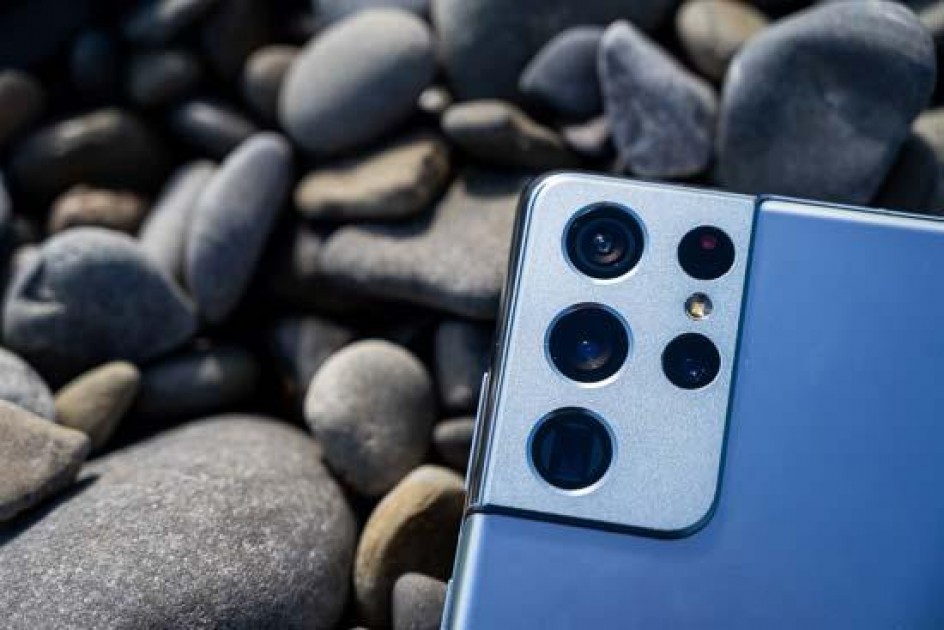Introduction
The GFX 100S is the fourth medium-format mirrorless camera that Fujifilm have released in the last few years.
As its name suggests, it has a 100 megapixel image sensor that physically meaures 43.8×32.9mm, which is much larger than the 36x24mm sensor found in a 35mm full-frame camera – approximately 1.7x larger in fact.
The Fuji 100S actually uses exactly the same sensor as the flagship GFX 100 camera, despite costing almost half as much as its bigger sibling.
This is a back illuminated CMOS sensor with 3.76 million phase detection autofocus points which cover almost 100% of the frame.
It offers much improved autofocusing speed, claimed to be up to twice as fast as the 50-megapixel GFX 50S and 50R models, which use a different sensor entirely.
The GFX100S uses the most powerful X-Processor 4 image processor, a feature that is again shared with the higher-end camera.
The native ISO range runs from ISO 100 to ISO 12,800, which is expandable to 50-102,400.
Just like the GFX 100, the 100S features in-body image stabilization (IBIS), but this time the five-axis image stabilisation system provides an even better compensation rating of up to 6 stops.
This is despite the fact that the 100S model is much smaller and lighter than the 100 model, so much so that Fujifilm had to completely redesign the IBIS unit from scratch to fit it into the smaller body.
The Fuji 100S also offers 4K 30p video recording with no crop at up to 400Mbps bitrate in 16:9 or 17:9 aspect ratios, again matching the GFX 100.
This can be recorded in 4:2:0 10-bit F-log internally to an SD card or 4:2:2 12-bit ProRes RAW via the HDMI port to an Atomos Ninja V Recording Monitor.
Other key specifications include a weather-resistant magnesium alloy body, 3.69M-dot OLED electronic viewfinder with 100% coverage and a magnification of 0.77x, 2.36 million dot tilting 3.2-inch LCD display, Face and Eye Detection AF, 5fps continuous shooting speeds, and dual UHS-II SD memory card slots.
The 100S also offers shutter speeds from 60 minutes to 1/4000th sec using the mechanical focal plane shutter or up to 1/16000 sec via the electronic shutter, interval shooting and multiple exposure modes, built-in Wi-Fi and Bluetooth connectivity, and a USB-C port.
The Fujifilm GFX 100S is priced at £5499 / $5999 body only in the UK and USA respectively.
Ease of Use
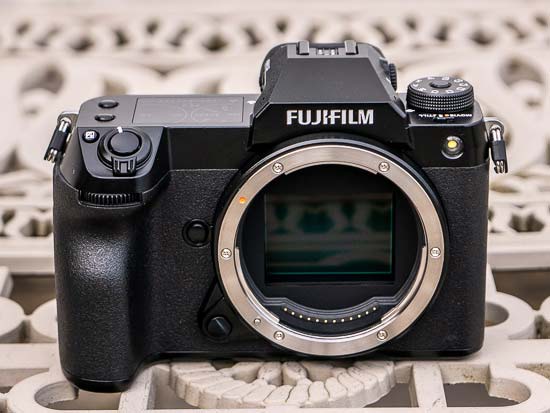 |
One line review – the new GFX 100S is half the size and half the price of the GFX 100, yet it offers the same 100 megapixel sensor, processor, AF system, and virtually all of the same features, even outperforming it in some ways.
Wow.
As well as rivalling its flagship sibling, the GFX 100S is also taking on the 35mm full-frame market by being similarly sized to some DSLR and mirrorless models, despite having a larger, medium format sensor.
With this new model, Fujifilm have clearly reduced the size and the price of the GFX 100S to take on the likes of the Sony Alpha 1, Canon EOS R5, Nikon Z7 II and Panasonic Lumix S1R, not to mention DSLRs like the Canon EOS 5D IV and Nikon D850.
Fujifilm’s new GFX marketing strapline is “More than full-frame”, but crucially that doesn’t mean more bulk or, compared to the Alpha 1, more cost (the 100S is actually cheaper than the Sony A1).
We haven’t even mentioned the GFX 100S’ medium format rivals, which with the exception of the now ageing Pentax 645Z are invariably larger and much, much more expensive than this camera.
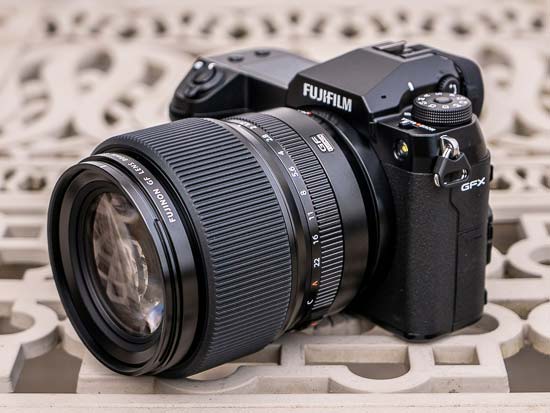 |
Despite having a medium format sensor, it’s clear to us that Fujifilm believes the GFX 100S main rivals are 35mm sensor cameras, not the “traditional” medium-format market that mainly serves studio photographers.
Fujifilm doesn’t have a 35mm camera range – instead it has the very popular APS-C X-series and the relatively new GFX medium-format series.
So it’s attacking the trending full-frame market from two angles – smaller, lighter and cheaper cameras like the X-T4, and now a medium-format camera that is similar in size, weight and even cost to the latest flagship 35mm models.
As ever with cameras, there’s no one model that does it all, though, so don’t expect the GFX 100S to rival smaller-sensor cameras for things like burst shooting speeds and auto-focus performance.
It is still very much a medium-format camera in theses areas, although Fuji have made great strides in improving them, especially compared to other medium-format models.
The most obvious stride forwards that Fujifilm have taken for the GFX 100S is the size and weight of it.
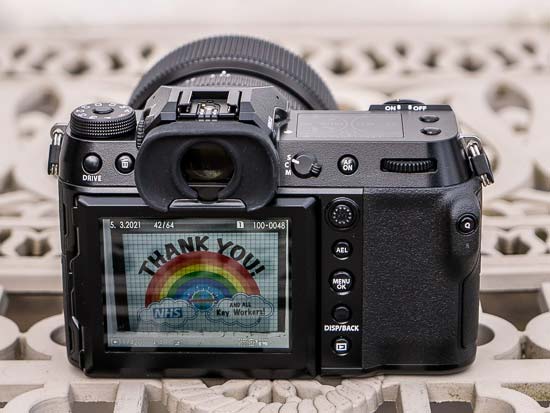 |
The Fuji 100S weighs 900g and measures 150×104.2×87.2mm, making it some 6cm (2.3in) shorter and 500g (1.1lb) lighter than the GFX100, which weighs in at 1400g and measuring 156.2×163.6×102.9mm.
This drastic reduction in size has mostly been achieved by removing the GFX100’s built-in vertical grip. Indeed, Fujifilm aren’t actually releasing an optional battery grip for the GFX 100S, and it doesn’t even have the electrical contacts on the bottom of the camera body, so there will be no 3rd-party options available either.
Instead there will be a metal hand grip accessory called the MHG-GFXS that enhances the in-hand feel of the camera, somewhat ironically by making it bigger.
So if you’re a fan of either fitting an optional battery grip to your camera for better battery life and improved ergonomics when shooting in portrait mode, sadly the GFX 100S won’t meet your needs, and you’ll need to consider the GFX 100 instead.
In terms of its size and weight, the GFX 100S is much closer to the very first GFX, the 50S. That camera measures 148x94x91 mm and weighs 920g, which is very similar to the new GFX 100S, but crucially it doesn’t have IBIS, unlike the 100S.
So Fuji’s engineers have made the 100S the same size as the 50S, but with the addition of an IBIS unit, something that typically makes a camera bigger. The IBIS mechanism inside the GFX 100S is actually 20% smaller and 10% lighter than the one found in the GFX 100.
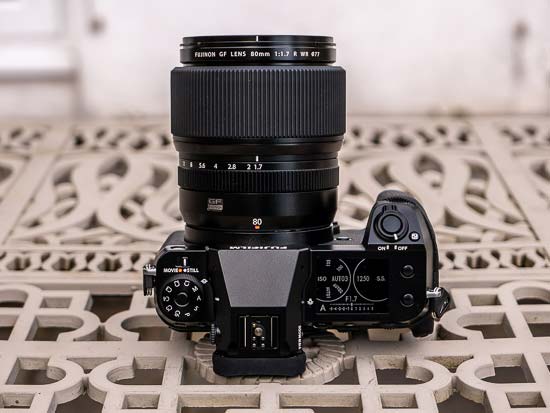 |
When you consider that the GFX 100S’ IBIS is slightly more effective than the one on the GFX 100 (6 stops vs 5.5 stops) and it uses exactly the same 102 megapixel medium-format sensor, it’s clear that you’re getting the best of both worlds.
This is the second GFX and second ever medium format camera to feature in-body image stabilization. The Fuji GFX 100S uses a familiar 5-axis system which provides up to 6 stops of image stabilization (when using the GF 63mm F2.8 R WR lens).
The two 50 megapixel GFX cameras didn’t have IBIS built-in, instead relying on the lens to provide it, which not all GFX lenses do. With the GFX 100S, any lens that you attach to it will automatically benefit from up to 6 stops of compensation. Furthermore, the same system is used to help suppress shutter shock, which given the incredible resolution on offer is a very welcome benefit.
Pixel Shift is a special Multi-Shot function that uses the IBIS unit to enable the GFX 100S to create 400 megapixel images. The camera’s IBIS unit is used to shift the image sensor by up to a pixel in various directions during a sequence of 16 shots, which can then be automatically combine into a single image using Fuji’s Pixel Shift Combiner software. The resulting DNG file measures 23,296×17,472 pixels and is around 1.5Gb in size!
Fuji also claim that the GFX 100S weighs only 160g more than a typical 35mm full-frame camera. We’re not quite sure which specific model they were comparing the 100S to, but having used it alongside the Panasonic Lumix S1R and Canon EOS 5D Mark IV, we can certainly vouch for the fact that the medium-format Fuji is in the same ball-park as at least some of its smaller-sensor rivals.
Fuji also redesigned the focal plane shutter unit in order to reduce the size of the 100S, but it still offers the same fastest shutter speed of 1/4000th second and the longest exposure time of 60 minutes. There’s also an electronic shutter which provides an even faster shutter speed of up to 1/16000 sec, which is useful for shooting in bright conditions at wide-open apertures, for example.
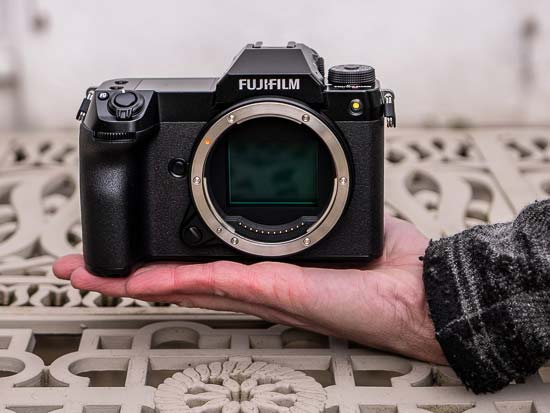 |
The third major design decision that has helped to make the GFX 100S so small, in addition to the new IBIS and shutter units and the loss of the vertical grip, is the adoption of a smaller battery.
The Fujifilm GFX 100S uses exactly the same NP-W235 battery as the X-T4 APS-C sensor camera, rather than the physically larger TP-125 battery used by the GFX 100 and the GFX 50S, and it’s incorporated into the bottom of the handgrip, again allowing the designers to make the 100S smaller.
The NP-W235 offers a CIPA-rated battery life of up to 465 shots on a single charge in normal mode, versus 400 shots for the TP-125, so it actually out-performs the bigger battery.
At least that’s the case for a single battery – as the GFX 100 can take two batteries in its integrated grip, the single-battery design of the GFX 100S means that it ultimately loses out to its bigger brother in this regard.
The Fuji GFX 100S is a very well-built camera, as you’d probably expect for £$6K, with absolutely no flex or movement in its chassis thanks to a die-cast magnesium alloy body and machined control dials.
It’s also dust-resistant, water-resistant and freeze-resistant down to -10°C, making this a medium format camera that can be used outside as well as indoors, further increasing its versatility.
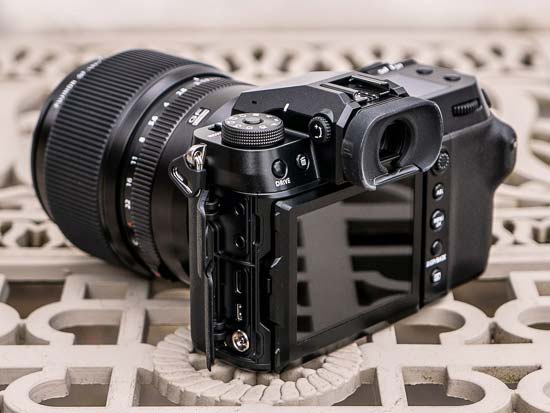 |
In terms of its ergonomics and control layout, 100S is the best realised GFX model yet, and the one that we’ve most enjoyed using, primarily because it handles just like a premium full-frame DSLR or mirrorless camera.
The front of the Fujifilm GFX 100S is adorned with the white Fujifilm logo positioned above the lens. To the left of the lens mount, if viewing the camera front-on, is a small black button that can be customised, which by default accesses the Performance Boost functions. On the bottom-left of the lens is a circular button for releasing the lens.
Thanks to the adoption of the NP-W235 battery and its placement, the 100S has a very large grip that I could comfortably fit even my pinky finger around whilst operating the shutter button with your forefinger and gripping the back of the camera with your thumb, which makes it exceptionally easy to hold for extended amounts of time. Even short periods of one-handed use are possible – how many medium format cameras can you say that about?
Just like they recently did with the X-S10 APS-C camera, Fujifilm have made the very-unlike-Fuji decision to somewhat simplify the design of the GFX 100S by not including the traditional shutter speed and ISO speed dials that adorn most of its cameras, including the GFX 50S that this camera most closely resembles.
Instead, there’s a traditional shooting mode dial on the left, complete with no less than 6 (!) Custom mode settings and the usual PASM modes, and a large, monochrome top-panel LCD screen on the right, a combination that’s just like the one on the GFX 100.
In front of the shooting mode dial is the brand new shooting mode switch, which toggles between Movie and Still. This is a welcome simplification of the way in which you chose these modes on the GFX 100, although you do lose top-panel access to the Drive modes, which are now instead accessed by the new Drive button on the rear of the camera.
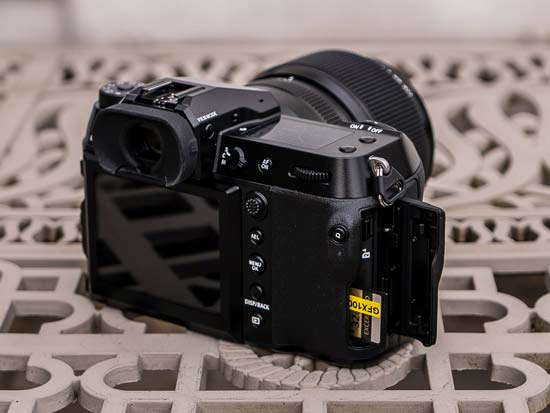 |
The 1.8″ top-panel LCD screen cleverly replaces the physical ISO and Shutter speed dials by displaying three “virtual” controls instead, with ISO on the left, shutter speed on the right and exposure compensation on the bottom.
Depending upon which shooting mode you’re in, as you use the front and rear control dials to change these settings, the virtual display is updated in real-time.
It can also be toggled using the small unmarked button to the bottom-right of the top LCD screen to alternatively display either a histogram or the Fuji GFX 100S’s current key settings, including the shutter speed, aperture, exposure compensation, sensitivity, shooting mode, white balance and film simulation mode.
It’s not quite as convenient as having actual dials, but is a clever idea nonetheless, especially as when set to the key settings mode, the LCD screen stays on when the camera is turned off, which acts as a quick reminder of your last used settings even before you turn the camera back on.
There’s also no handy exposure compensation dial, however, instead replaced by a tiny dedicated button on top of the camera next to the shutter button that’s rather awkwardly used in conjunction with the rear control dial.
Completing the top of the camera is a small button for illuminating the top LCD panel, an unmarked, re-configurable Function button that by default toggles Face Detection on and off, and an On/Off switch that surrounds the shutter release button – this isn’t threaded for a traditional shutter release cable, though, as on some X-series cameras.
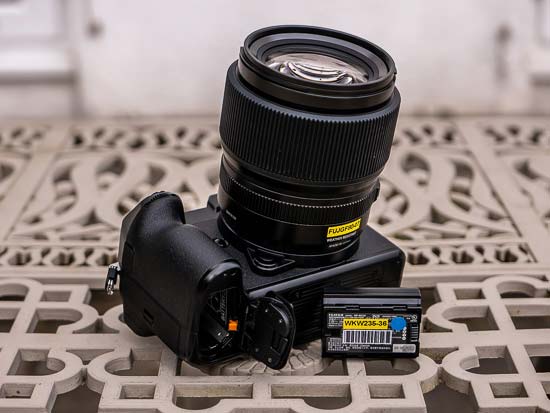 |
The Fujifilm GFX 100S is equipped with exactly the same 43.8×32.9mm CMOS sensor as the GFX 100, with a resolution of 102 megapixels and no optical low pass filter that delivers 11648×8736 pixel still images.
This chip has an imaging area that’s 1.7x greater than that of a 35mm “full-frame” sensor, and over 3.7 times larger than the APS-C sized sensors used in Fujifilm’s X-series cameras. Unlike those cameras, though, the Fujifilm GFX 100S has a traditional Bayer colour filter array in front of the sensor, rather than an X-Trans sensor.
The combination of the image sensor and X-Processor 4 processing engine also means that the camera supports 16-bit RAW mode in single-shot mode (it drops to 14-bit in the burst shooting modes), producing 200Mb files. The GFX 100S also supports 16-bit TIFF in-camera file conversion, which creates whopping 600Mb files!
The Fujifilm GFX 100S has a dual phase-detection and contrast-detection type autofocus system, thanks to the 3.76 million phase-detection AF pixels that are embedded in the sensor.
It actually uses the same AF algorithm adopted from the fourth generation X-Series cameras (X-T3 and X-T30). This makes the GFX 100S much quicker to auto-focus than the 50S and 50R cameras, taking about 0.20 second to lock on to the subject and proving to be less prone to hunting in dimmer environments.
The 100S has a brand new thumb-operated 8-way Focus Lever joystick on the rear, which now provides additional diagonal control that very quickly and easily allows you to move the AF point to one of the 117 different points that cover most of the frame in a 9×13 configuration.
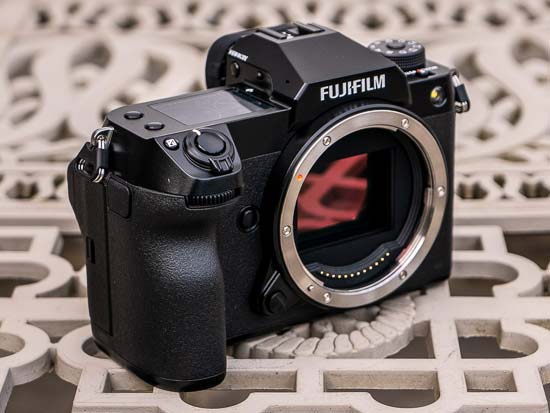 |
The AF point can be set to one of six different sizes via the rear control dial to achieve more precise focusing, and you can also simply tap on the touchscreen to set the AF point. If you want even more control, you can select the 425 points option which splits the same area of the frame into a 17×25 grid of smaller AF points.
The Fuji GFX 100S also offers Zone and Wide/Tracking modes which utilise the larger 425-point area to capture moving subjects.
In Zone mode, you can select a 3×3, 5×5 or 7×7 zone out of the 425-point AF area. During AF-C focus, the camera continually tracks the subject, positioning it at the centre of the zone.
The Wide/Tracking mode combines the Wide mode (during AF-S), in which the GFX 100S automatically identifies and tracks the area in focus across the 425 point AF area, and the predictive Tracking mode (during AF-C), which uses the entire 425-point area to continue tracking the subject. This feature enables continuous focusing on a subject that is moving up and down, left and right or towards and away from the camera.
Manual focus is also provided, and very good it is too. As you’d expect, the manual focus rings on all the GFX lenses have a lovely feel, and two different focusing aids are provided – auto magnification and focus peaking. In conjunction with the high-resolution electronic viewfinder, we found it easy to accurately determine critical sharpness.
The Fuji GFX 100S offers a continuous shooting rate of 5fps with continuous AF for 16 compressed Raw files if you use a UHS-II SDXC card and the mechanical shutter, just surpassing the buffer depth of the GFX 50S (which is 14 Raw files) and making it one of the fastest medium format cameras on the market, impressive given the size of the 102 megapixel files. If you prefer to use the electronic shutter, the fastest shooting rate drops to 2.9fps.
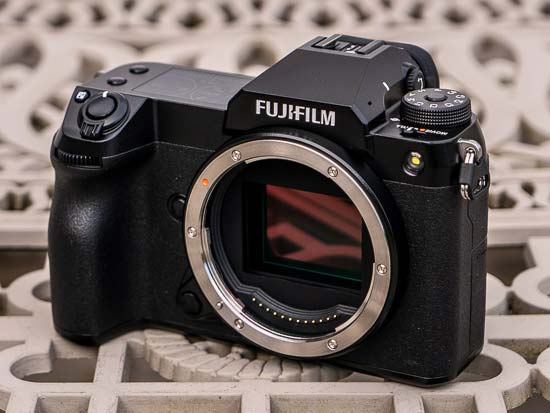 |
The Fujifilm GFX 100S matches the more expensive GFX 100 when it comes to video, also supporting DCI 4K quality at 29.97, 25, 24, and 23.98 fps at up to 400Mbps and Full HD up to 60fps in either the H.265 or H.264 formats.
Note that 4:2.2 10bit is only available when recording out via the HDMI port, with 4:2.0 10bit going to the SD cards (in the H.265 mode).
The new model does offer one video improvement over the GFX 100 – it can now record continuously for up to 120 minutes, double the maximum length of its predecessor.
There are both 3.5mm Mic and 3.5mm Headphone ports on the left-hand flank of the camera when viewed from the rear, with USB-C, HDMI and an X-Sync flash socket below them.The GFX 100S can be powered and charged via the USB-C connection, which is useful if you’re out and about and have a compatible powerbank to plug the camera into.
Two memory card slots are located on the right-hand flank of the camera when viewed from the rear. The GFX 100S offers compatibility with Ultra High Speed UHS-II SDXC memory cards, which has the main benefit of increasing the data writing speed in continuous mode to about twice that of a conventional UHS-1 card.
Also located on the right of the camera body is the Remote socket, hidden under it’s own flap.
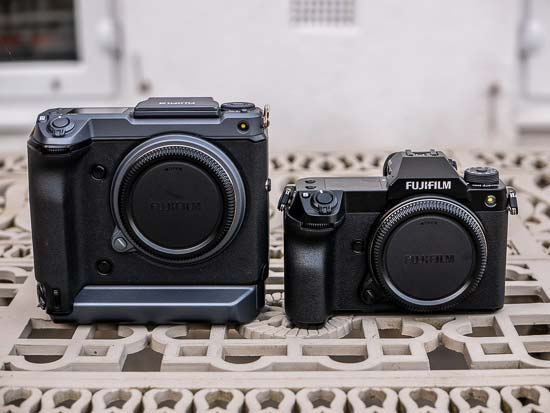 |
The Fuji GFX 100S features both built-in wi-fi and Bluetooth connectivity. The latter option creates a constant, low-power connection between the camera and a smartphone/tablet to transfer images and video using the Fujifilm Camera Remote smartphone app, while the former allows you to remotely control the GFX 100S via a 2.4Ghz wi-fi connection using a smartphone or tablet and the Fujifilm app, and transfer images and video from one device to the other.
We tested the Fujifilm GFX 100S with a number of different native GFX lenses, all of which feature a focal-plane shutter, allowing for shutter speeds as fast as 1/4000th of a second. The lenses also have an aperture ring and a C (Command) position on the ring to enable aperture adjustments via a command dial on the camera body, and they all boast the same dust- and weather-resistant construction as the body.
With its focal-plane mechanical shutter, the Fujifilm GFX 100S has a top shutter-speed limit of 1/4000th second in all shooting modes. This allows you to select a faster aperture even in bright conditions or when shooting with flash during the day, although there’s no built-in ND filter.
The GFX 100S also has an electronic shutter in addition to the mechanical one, which provides a much faster top shutter speed of 1/16,000th second. This allows you to continue shooting wide-open with fast aperture lenses in the brightest of conditions without having to resort to fitting a glass ND filter or using external flash and lights.
There are some important caveats with the electronic shutter – the ISO range is restricted to 100-12800 and you can’t use an external flashgun, but overall it’s a great feature that makes the GFX 100S more versatile.
Rather than a traditional optical viewfinder, the Fuji GFX 100S employs the same 3.69M-dot OLED electronic viewfinder that the GFX 50S used, which is 0.5 inch in size and 100% scene coverage. The magnification on the 50S is higher though – 0.85x versus 0.77x magnification on the 100S.
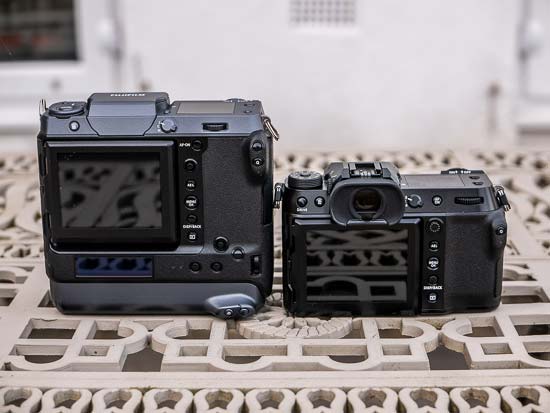 |
Unlike the GFX 100, this electronic viewfinder is fixed in place and not removable, and it also has lower resolution and magnification – the 100 model boasts a class-leading 5.76M-dot OLED electronic viewfinder with 0.86x magnification.
The size of the rear LCD screen is 3.2-inches and the resolution is an impressive 2.36m-dots, exactly the same as the screen on the GFX 50S and 100. It can also be usefully tilted up and down by about 90 degrees when in landscape mode and upward when shooting in portrait mode via a simple press of a button on the side.
The Fujifilm GFX 100S has an intuitive touchscreen interface, allowing you to either move the AF point or simultaneously move the AF point and focus on the subject.
On the right-hand side of the screen is a small icon which if you press it allows you to choose between using the screen to set the AF point, or to have it focus as well. If you prefer, you can turn off this functionality altogether, but it is quicker than using the joystick to set the AF point.
One drawback to leaving the touchscreen AF on is that we kept inadvertently moving the AF point when changing lenses or using the EVF. In image playback, you can simply drag left and right to go through the sequence of images and pinch/double-tap to zoom in and out, although you still can’t use the main menu system via the touchscreen.
Unlike the GFX 100 with its rather unfamiliar design, the rear panel of the 100S will feel more welcoming to anyone who has ever handled a Fujifilm X-series camera before.
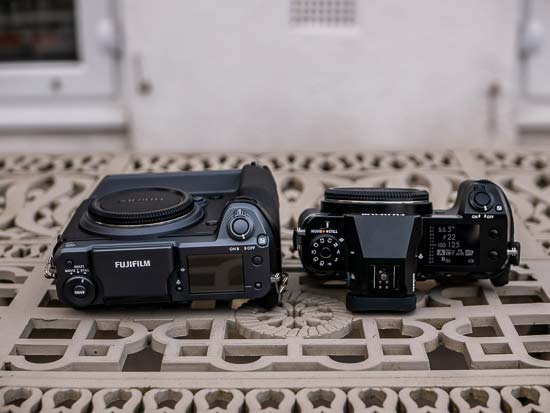 |
There’s the aforementioned Drive button and a Delete button located to the left of the EVF and an AF Mode dial (S/C/M) on the right, with a small AF On button for back-button focusing and the rear control dial alongside that.
The tiny Quick Menu button is set into the rear thumb rest. This provides quick access to lots of frequently used shooting settings including the ISO speed, White Balance, File Size and File Quality, with either the focus joystick, front control dial or the touchscreen used to quickly change between them.
Instead of a traditional 4-way controller with a centred Menu/OK button, the Fujifilm GFX 100S has a vertical column of buttons, starting with the new, tactile 8-way joystick which is primarily used for setting the AF point and then the AE-Lock button.
Underneath those controls in the Menu/OK button which accesses the seven different Shooting and Set-up menus, the Disp/Back button which is used for changing the LCD display or going back, and finally the Playback button.
The base of the camera features a screw tripod thread that’s inline with the centre of the lens mount and the battery compartment.
In summary, the GFX 100S is the smallest GFX camera that Fujifilm have ever made and the most intuitive and best-handling too. The fact that it also makes very few concessions in terms of features and performance to the much more expensive GFX 100 model is the icing on the proverbial cake.


